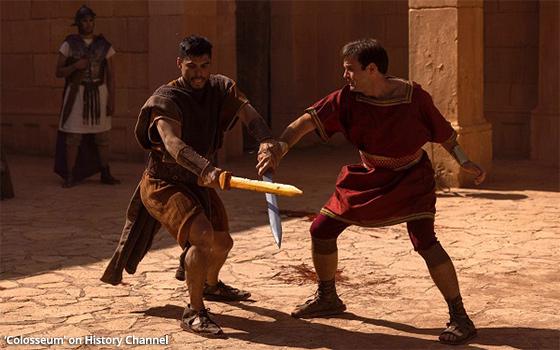Commentary
History Channel's 'Colosseum' Combines Fun Facts, Gruesome Gore
- by Adam Buckman , Featured Columnist, July 15, 2022

A new History Channel series about the Colosseum in Rome places this famous, ancient arena at the very center of world history.
“The Colosseum would come to symbolize the rise and fall of Rome,” says one historian in the introductory segment of Episode One of the series, titled simply “Colosseum.”
“The Colosseum in Rome is one of the most iconic structures in the history of humanity,” says another.
These claims might strike some as overstated and possibly even unsupportable. But since few who will watch this show are likely to be experts in the history of the Roman Empire, the story the show tells seems accurate enough.
Like other historical series History Channel has presented in the last few years, this one combines the testimony of historians with dramatic reenactments of events such as, in this case, the pageantry of public rallies convened to cheer the emperor and the hand-to-hand combat in the arena that was staged for the entertainment of the Roman multitudes.
advertisement
advertisement
This is a formula that has borne fruit for History Channel. Similar limited series designed on similar lines included “Washington” in February 2020 and “Grant” later that year starting on Memorial Day.
The TV Blog gave the “Grant” series a thumbs-up here in May 2020, but with a big reservation -- its excessive violence.
“At times, the makers of this show laid on the battlefield violence more gratuitously than they had to,” opined the TV Blog of “Grant.”
The same reservation arises with “Colosseum,” which packs more blood spatter into a single, 45-minute episode than an entire season of “Dexter.”
The makers of “Colosseum” apparently aimed to re-create its gladiator combat as realistically as they could, keeping in mind that they do not really have anything to really base this interpretation on, other than “Gladiator” (2000) starring Russell Crowe.
Thus, the show is rife with squishy stabbings, slashings and, in at least one instance, the obliteration of someone’s head with a well-aimed sledgehammer or broadaxe.
“Colosseum” consists of eight, one-hour episodes. The first episode, titled “The Gladiators,” takes up the story of the Colosseum in 80 A.D., the year it was completed.
The series goes on to survey the history of this building, much of which still stands in Rome, from the year of its opening to its last hurrah, estimated to have been in the year 404.
For those who are largely unbothered by the kind of gore that characterizes much of this show’s reenactments, there is much to learn from the historians in the show.
In the first episode alone, the recruitment and enslavement of the gladiators is fully detailed. Among the factoids new to me: Gladiator battles were not staged as fights to the death, as so many of us assume today.
Instead, says one historian, deaths in gladiator combat were not intended. She estimates that perhaps 1 in 10 gladiators died in the arena.
But she also notes that the “owners” of these enslaved warriors had huge investments tied up in their fighters, including training and feeding them.
The last thing they wanted was for their “star” fighters to be killed. When this happened, the deaths represented a financial loss.
“Colosseum” premieres on Sunday (July 17) at 9 p.m. Eastern on History Channel.



